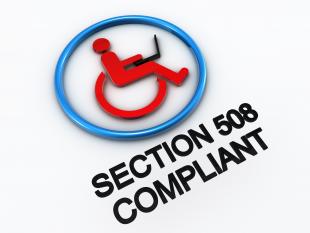508 Compliant Training: What Does Section 508 Mean for You?


"Accessibility" is an elusive trait in elearning, as in life. Many elearning sellers create "accessible" courses, and it's a popular feature for courses in the OpenSesame elearning marketplace. Nonetheless, we get tons of questions about what "accessible" really means. Whenever I get a pile of questions about the same topic, I know it's time for a blog post. So, by popular demand, here's a primer on accessibility and section 508 compliance for learning and development professionals.
Section 508 is an amendment to 1973’s Workforce Rehabilitation Act, signed by President Bill Clinton in 1998. Section 508 states that electronic and information technology (EIT) that is purchased or developed by federal agencies must be accessible by individuals with disabilities. This amendment provided enforceable standards and reporting requirements and a complaint procedure to further strengthen the law.
Who defines what is “accessible” to individuals with disabilities? Thie United States Access Board. Section 508 declared the Access Board responsible for defining accessibility through a set of standards. With the help of the Electronic and Information Technology Access Advisory Committee in October 1998, the Access Board devised a “proposed rule” in March 2000, which later – after a period of public comment - became the final rule, enforced as of June 2001. It is this final rule that provides all of the standards for accessibility in electronic and information technology – and these standards are the central core of Section 508.
In a nutshell, Section 508 establishes accessibility standards for all types of information and communication technologies. And this includes elearning courses. Ensuring that your content is accessible means careful consideration of several factors:
- Is visual content presented in a structure that can be interpreted by screen reading software? Do you use the principles of good design to ensure that you have a consistent hierarchy of information?
- Is information presented through audio accessible through other means? Do you provide transcripts or other visual representation of information for those who don't have the ability to listen to your course.
- Is your navigation intuitive and accessible? Do you rely on color coding for users to interpret the content of a button, for example?
So, why is Section 508 important to you as an elearning developer? Federal agencies require accessibility. Federal Agencies are obliged to purchase elearning courses that are accessible and compliant to Section 508 standards. If faced with the choice of two possible purchases, the elearning course that meets 508 compliance standards should get the contract. Many private sector customers prefer 508 compliance. Federal agencies are not the only customers who care about using elearning courses that are accessible to all of their employees. Many diverse elearning buyers rely on accessible courses to create a universal workplace, in which all employees have shared access to learning and development resources.
A Course for Learning More
Are you interested in developing, managing and implementing elearning courses under Section 508 standards? OpenSesame seller Halcyon Educational Technology has developed an elearning course, "508 Compliance for eLearning," which is designed to provide Section 508 training for elearning developers. So, this is an elearning course about designing elearning courses - very meta.
Zuma provides a thorough introduction to the tenets of elearning course design to meet Section 508 requirements, including an explanation of the criteria for evaluating courses and an introduction to techniques for accessible course design. You’ll also gain a broad understanding of the concept of “accessibility” in the design of elearning courses, which will drive you not only to create accessible courses but to create high quality, clear content.
Click here for more info on Halcyon Educational Technology’s Section 508 regulatory compliance training.



